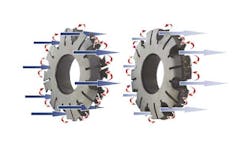The filtration technology developed by Magnom removes sub-micron and larger-sized contaminants from hydraulic fluid using a combination of magnets and specially formed steel plates to collect particles. Housed around central magnets, the steel plates transmit magnetic fields that attract ferrous and other magnetically sensitive particles into collection zones between the plates.
The plates are arranged as positive-negative pairs, and because opposite charges attract, positively charged particles are drawn into negatively charged collection zones formed between pairs of plates. Likewise, negatively charged particles are drawn into positively charged collection zones. Ferrous particles tend to hold a positive or negative charge, so they will be attracted either to a negative or positive collection zone.
Furthermore, flow pulses and surges—inherent to most hydraulic systems—do not dislodge the particles from the collection zones because trapped particles are not in the main stream of fluid flow. Furthermore, magnetic fields (opposite charges) hold particles within the collection zones. For the particles to exit the collection zones, they would have to overcome the magnetic force of a pair of like-charged plates. In essence, then, the particles are held in place by the attraction of opposite charges and the repulsive force of like charges.
The hard, small particles of ferrous metals typically found in hydraulic systems are too small to be trapped by even the finest media-type filters. Plus, these particles typically have sharp edges and are dense, so they can tear the media when they pass through the filter, shortening media life. Removing these contaminants extends the life of components within the system and improves reliability.
This file type includes high resolution graphics and schematics when applicable.
Unlike media filters, Magnom cores do not create an increasingly high pressure drop as more contamination collects. This is because particles collect in areas away from flow paths. This means pressure drop is not a factor when applying Magnom components. The cores are sized so that the flow area around all the steel plates equals or exceeds the flow area of inlet and outlet ports.
Magnom cores should not be used to replace conventional, media-type filters. Instead, they improve system filtration and extend the life of media filters (see "Strength in Numbers" to read about its application in Caterpillar bulldozers). They do this by trapping particles that would otherwise collect in filter elements, and they remove the hardest, most damaging particles from the flow stream.



